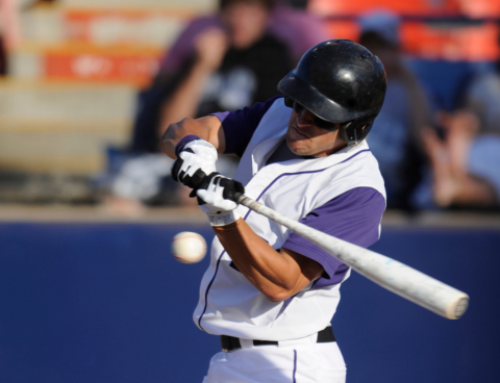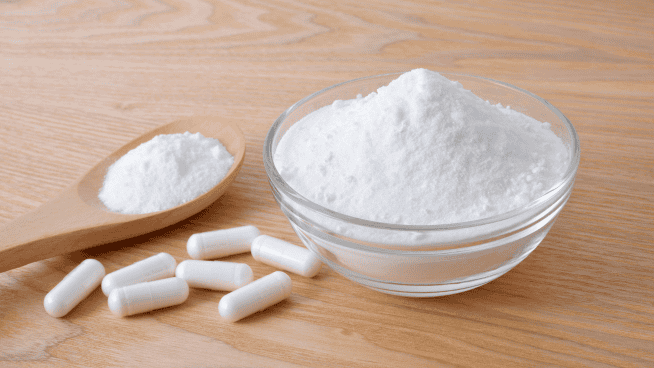Facing the toughest challenge of his life in the 1993 comedy The Sandlot, Benny “The Jet” Rodriguez is visited in a dream by Babe Ruth—”The Great Bambino”—who proclaims, “Everybody gets the chance to do something great. Most people never take the chance, either because they’re too scared, or they don’t recognize it when it spits on their shoes.”
Rodriguez’s moment of greatness occurs the following day when he clears the fence into Mr. Mertle’s yard, scoops up the Babe Ruth-autographed ball, and eludes Hercules—“The Beast”—in a foot race through town. The legend of The Jet picks up years later when he becomes a member of the hometown Los Angeles Dodgers. The rest is history.
There are countless real-life Benny Rodriguezes out there, baseball players who were destined for greatness the moment they picked up a bat and glove. However, few call an audible on their promising baseball futures in pursuit of a different career. Even fewer achieve success after making the transition.
Here is a list of the top nine former baseball players who became stars in the National Football League.
Russell Wilson
Position: CF/2B
Bat/Throw: R/R
Drafted: Fourth round (no. 140 overall) in 2010 by the Colorado Rockies
The converted second baseman played in 32 games of short-season rookie ball with the Tri-City Dust Devils, then resumed his pro ball career the following spring with the Rockies’ Class A affiliate, the Asheville Tourists, where in 61 games he hit .228 with three home runs and 15 RBI.
Despite Wilson’s high upside—he was rated the fastest base runner and best athlete in the Rockies organization—he decided to give up baseball in pursuit of a career in the NFL. He is currently the starting quarterback for the Seattle Seahawks.
Brandon Weeden
Position: P
Bat/Throw: R/R
Drafted: Second round (no. 71 overall) in 2002 by the New York Yankees
The Yankees used their first pick of the 2002 amateur draft to select Weeden, a high school pitcher from Oklahoma. He was the final player chosen in a second round loaded with talent, including future All Stars Joey Votto, Jon Lester and Brian McCann.
Weeden spent five seasons in the minors playing for three organizations—the Yankees, Los Angeles Dodgers and Kansas City Royals—but his career stalled at the Class A level. “From the time I was 18 years old, I knew that if I had a bump in the road with baseball, I could always go back and play football,” Weeden told Yahoo! Sports prior to the 2012 NFL Draft, in which he was selected 22nd overall. He is currently the starting QB for the Cleveland Browns.

Baseball helped Golden Tate enhance his skills and athleticism to become an elite wide receiver.
Golden Tate
Position: OF
Bat/Throw: L/L
Drafted: 42nd round (no. 1,252 overall) in 2007 by the Arizona Diamondbacks
As a sophomore at Notre Dame, Tate started 54 games in left field, hitting .329 with eight doubles, one home run and 21 RBI. He also picked up 13 stolen bases on 14 attempts and was third on the team with 45 runs scored.
Originally drafted by the Diamondbacks out of high school, Tate was again selected in the 2010 amateur draft by the San Francisco Giants, a little over a month after the Seahawks selected him in the second round of the NFL Draft.
Although he never pursued a professional baseball career, the 2009 Biletnikoff Award winner credits baseball with helping him acquire the skills needed to play in the NFL. Tate says, “Baseball helped me learn how to catch the ball at its highest point, which improved my ability at the wide receiver position.” (watch video below of Tate talking about his baseball career.)
Jake Locker
Position: CF
Bat/Throw: R/R
Drafted: 10th round (no. 321 overall) in 2009 by the Los Angeles Angels
In 2008, Baseball America named Locker the top prospect of the West Coast Collegiate Baseball League, where he hit .273 with two doubles and a homer in 10 games with the Bellingham Bells.
The Angels selected Locker in the 10th round of the 2009 amateur draft, despite the fact that he had not played a full season of baseball since high school, when he was named the 3A Player of the Year in the State of Washington.
Locker agreed to a contract with the Angels and received a $250,000 signing bonus. He has yet to play a game as a member of the Angels organization, which owns his rights until 2015. He has, however, started 10 games at quarterback for the Tennessee Titans.
Tom Brady
Position: C
Bat/Throw: L/R
Drafted: 18th round (no. 507 overall) in 1995 by the Montreal Expos
The legend of Brady grows even larger with the discovery that the great Patriots field general was nearly a big-league catcher for the Expos.
During his two years of high school varsity baseball, Brady played 61 games and hit .311 with eight homers, 11 doubles and 44 RBI. However, he was more than just a power-hitting catcher. Brady was a rare find on the baseball diamond, according to his high school coach, Pete Jensen.
“Tommy’s makeup was just so fantastic—the leadership, competitiveness and the athletic tools,” Jensen said in a 2011 interview with the Globe and Mail. “I actually felt he was a better baseball player in high school than he was a football player. I told everyone he would play in the majors some day.”
In the end, teams were reluctant to spend an early-round draft pick on Brady, who had expressed his intention to play football at the University of Michigan. Football turned out to be a good choice, as Brady has amassed two NFL MVP awards and three Super Bowl rings with the Patriots.
Colin Kaepernick
Position: P/1B
Bat/Throw: R/R
Drafted: 43rd round (no. 1310 overall) in 2009 by the Chicago Cubs
As a senior at Pitman High School in Turlock, Calif., the hard-throwing Kaepernick tossed two no-hitters and posted a 9-2 record on the hill. He reportedly received partial baseball scholarship offers from Notre Dame, Tennessee and Arizona State, but opted instead to accept the lone football scholarship presented to him—by the Nevada Wolf Pack.
Despite record-setting performances at Nevada—Kaepernick became the first player in NCAA history to record consecutive 2,000-yard passing/1,000-yard rushing seasons—some football insiders weren’t sold on his NFL potential until after his senior season.
Tim Wilken, scouting director for the Cubs, recently told CSN Chicago, “When we went to our NFL sources, they thought he was just going to be a CFL guy. Our football guys said that he had a sling in his arm action and they didn’t think that was going to work in the NFL.” In just his second NFL season, Kaepernick has found full-time work slinging the ball downfield for the San Francisco 49ers.

Eric Decker possessed the speed, size and power to be a big league outfielder.
Eric Decker
Position: LF/CF
Bat/Throw: L/L
Drafted: 27th round (no. 822) overall in 2009 by the Minnesota Twins
Decker hit .329/.439/.478 as a freshman at Minnesota. His sophomore season wasn’t as productive as he had to deal with nagging injuries suffered during the football season.
“He reminds me of Kirk Gibson with the body, the speed and the power,” said longtime Golden Gophers assistant head coach Rob Fornasiere in 2009.
Regarding his pro potential, Baseball America wrote before the 2009 amateur draft, “While he’s not putting up huge numbers, it’s still easy to dream of Decker becoming a star after he gets 1,500 or so minor league at-bats under his belt.” Decker didn’t have to wait that long to see the field, since he was drafted as a wide receiver by the Denver Broncos in 2010.
Toby Gerhart
Position: OF
Bat/Throw: R/R
Drafted: N/A
Per the Stanford athletics site, “Gerhart complements power to all fields with excellent speed … [and is] a great defensive outfielder with an above-average arm.”
In two seasons on the Stanford Cardinal baseball team, Gerhart posted a .264 batting average with 12 doubles, nine home runs and 33 RBI in 86 games, including 52 starts. The single-season rushing leader at Stanford turned in a 3-for-4 performance with three runs scored and a solo homer in a College World Series game against the Florida State Seminoles. Gerhart currently spells Adrian Peterson as a running back for the Minnesota Vikings.
Dennis Dixon
Position: OF
Bat/Throw: L/R
Drafted: Fifth round (no. 168 overall) in 2007 by the Atlanta Braves
The Atlanta Braves selected Dixon behind Jason Heyward and Freddy Freeman, both of whom have lived up to their big-league potential early in their careers. Dixon was viewed as a star in the making, too. When the Cincinnati Reds first drafted him in 2003, he was viewed as a “potential 25-30 home-run hitter … [and] potential frontline major league outfielder,” according to his draft profile. Instead, Dixon went on to play quarterback for the Pittsburgh Steelers and Baltimore Ravens.
Honorable Mention
Michael Vick
Despite not having played baseball since the eighth grade, Vick displayed enough speed and athleticism as a freshman QB at Virginia Tech to prompt the Colorado Rockies to take a late-round flier, selecting him in the 30th round of the 2000 draft. Bill Schmidt, the Rockies’ scouting director at the time, said, “When you can run like him, our feeling was he could cover some ground for us in the outfield.”
Fun fact: Vick was selected 19 spots ahead of San Francisco Giants closer Brian Wilson, who was originally drafted by the Cleveland Indians in 2000. Wilson did not sign with the Tribe and was drafted by the Giants in 2003.
Cedric Benson
A 12th-round pick by the Los Angeles Dodgers in 2001, Benson played with the Dodgers’ rookie league clubs in Vero Beach, Fla., during the summers before his freshman and sophomore years at the University of Texas, before ultimately deciding to give up pro baseball to pursue a career in the NFL.
Ricky Williams (Retired)
The Philadelphia Phillies selected Williams in the eighth round (no. 213 overall) of the 1995 amateur draft. The New York Mets selected A.J. Burnett four picks later. Check out the video above!
Illustration: Jack Kruyne
Photos: Notre Dame Media Relations // University of Minnesota Athletics
RECOMMENDED FOR YOU
MOST POPULAR
Facing the toughest challenge of his life in the 1993 comedy The Sandlot, Benny “The Jet” Rodriguez is visited in a dream by Babe Ruth—”The Great Bambino”—who proclaims, “Everybody gets the chance to do something great. Most people never take the chance, either because they’re too scared, or they don’t recognize it when it spits on their shoes.”
Rodriguez’s moment of greatness occurs the following day when he clears the fence into Mr. Mertle’s yard, scoops up the Babe Ruth-autographed ball, and eludes Hercules—“The Beast”—in a foot race through town. The legend of The Jet picks up years later when he becomes a member of the hometown Los Angeles Dodgers. The rest is history.
There are countless real-life Benny Rodriguezes out there, baseball players who were destined for greatness the moment they picked up a bat and glove. However, few call an audible on their promising baseball futures in pursuit of a different career. Even fewer achieve success after making the transition.
Here is a list of the top nine former baseball players who became stars in the National Football League.
Russell Wilson
Position: CF/2B
Bat/Throw: R/R
Drafted: Fourth round (no. 140 overall) in 2010 by the Colorado Rockies
The converted second baseman played in 32 games of short-season rookie ball with the Tri-City Dust Devils, then resumed his pro ball career the following spring with the Rockies’ Class A affiliate, the Asheville Tourists, where in 61 games he hit .228 with three home runs and 15 RBI.
Despite Wilson’s high upside—he was rated the fastest base runner and best athlete in the Rockies organization—he decided to give up baseball in pursuit of a career in the NFL. He is currently the starting quarterback for the Seattle Seahawks.
Brandon Weeden
Position: P
Bat/Throw: R/R
Drafted: Second round (no. 71 overall) in 2002 by the New York Yankees
The Yankees used their first pick of the 2002 amateur draft to select Weeden, a high school pitcher from Oklahoma. He was the final player chosen in a second round loaded with talent, including future All Stars Joey Votto, Jon Lester and Brian McCann.
Weeden spent five seasons in the minors playing for three organizations—the Yankees, Los Angeles Dodgers and Kansas City Royals—but his career stalled at the Class A level. “From the time I was 18 years old, I knew that if I had a bump in the road with baseball, I could always go back and play football,” Weeden told Yahoo! Sports prior to the 2012 NFL Draft, in which he was selected 22nd overall. He is currently the starting QB for the Cleveland Browns.

Baseball helped Golden Tate enhance his skills and athleticism to become an elite wide receiver.
Golden Tate
Position: OF
Bat/Throw: L/L
Drafted: 42nd round (no. 1,252 overall) in 2007 by the Arizona Diamondbacks
As a sophomore at Notre Dame, Tate started 54 games in left field, hitting .329 with eight doubles, one home run and 21 RBI. He also picked up 13 stolen bases on 14 attempts and was third on the team with 45 runs scored.
Originally drafted by the Diamondbacks out of high school, Tate was again selected in the 2010 amateur draft by the San Francisco Giants, a little over a month after the Seahawks selected him in the second round of the NFL Draft.
Although he never pursued a professional baseball career, the 2009 Biletnikoff Award winner credits baseball with helping him acquire the skills needed to play in the NFL. Tate says, “Baseball helped me learn how to catch the ball at its highest point, which improved my ability at the wide receiver position.” (watch video below of Tate talking about his baseball career.)
Jake Locker
Position: CF
Bat/Throw: R/R
Drafted: 10th round (no. 321 overall) in 2009 by the Los Angeles Angels
In 2008, Baseball America named Locker the top prospect of the West Coast Collegiate Baseball League, where he hit .273 with two doubles and a homer in 10 games with the Bellingham Bells.
The Angels selected Locker in the 10th round of the 2009 amateur draft, despite the fact that he had not played a full season of baseball since high school, when he was named the 3A Player of the Year in the State of Washington.
Locker agreed to a contract with the Angels and received a $250,000 signing bonus. He has yet to play a game as a member of the Angels organization, which owns his rights until 2015. He has, however, started 10 games at quarterback for the Tennessee Titans.
Tom Brady
Position: C
Bat/Throw: L/R
Drafted: 18th round (no. 507 overall) in 1995 by the Montreal Expos
The legend of Brady grows even larger with the discovery that the great Patriots field general was nearly a big-league catcher for the Expos.
During his two years of high school varsity baseball, Brady played 61 games and hit .311 with eight homers, 11 doubles and 44 RBI. However, he was more than just a power-hitting catcher. Brady was a rare find on the baseball diamond, according to his high school coach, Pete Jensen.
“Tommy’s makeup was just so fantastic—the leadership, competitiveness and the athletic tools,” Jensen said in a 2011 interview with the Globe and Mail. “I actually felt he was a better baseball player in high school than he was a football player. I told everyone he would play in the majors some day.”
In the end, teams were reluctant to spend an early-round draft pick on Brady, who had expressed his intention to play football at the University of Michigan. Football turned out to be a good choice, as Brady has amassed two NFL MVP awards and three Super Bowl rings with the Patriots.
Colin Kaepernick
Position: P/1B
Bat/Throw: R/R
Drafted: 43rd round (no. 1310 overall) in 2009 by the Chicago Cubs
As a senior at Pitman High School in Turlock, Calif., the hard-throwing Kaepernick tossed two no-hitters and posted a 9-2 record on the hill. He reportedly received partial baseball scholarship offers from Notre Dame, Tennessee and Arizona State, but opted instead to accept the lone football scholarship presented to him—by the Nevada Wolf Pack.
Despite record-setting performances at Nevada—Kaepernick became the first player in NCAA history to record consecutive 2,000-yard passing/1,000-yard rushing seasons—some football insiders weren’t sold on his NFL potential until after his senior season.
Tim Wilken, scouting director for the Cubs, recently told CSN Chicago, “When we went to our NFL sources, they thought he was just going to be a CFL guy. Our football guys said that he had a sling in his arm action and they didn’t think that was going to work in the NFL.” In just his second NFL season, Kaepernick has found full-time work slinging the ball downfield for the San Francisco 49ers.

Eric Decker possessed the speed, size and power to be a big league outfielder.
Eric Decker
Position: LF/CF
Bat/Throw: L/L
Drafted: 27th round (no. 822) overall in 2009 by the Minnesota Twins
Decker hit .329/.439/.478 as a freshman at Minnesota. His sophomore season wasn’t as productive as he had to deal with nagging injuries suffered during the football season.
“He reminds me of Kirk Gibson with the body, the speed and the power,” said longtime Golden Gophers assistant head coach Rob Fornasiere in 2009.
Regarding his pro potential, Baseball America wrote before the 2009 amateur draft, “While he’s not putting up huge numbers, it’s still easy to dream of Decker becoming a star after he gets 1,500 or so minor league at-bats under his belt.” Decker didn’t have to wait that long to see the field, since he was drafted as a wide receiver by the Denver Broncos in 2010.
Toby Gerhart
Position: OF
Bat/Throw: R/R
Drafted: N/A
Per the Stanford athletics site, “Gerhart complements power to all fields with excellent speed … [and is] a great defensive outfielder with an above-average arm.”
In two seasons on the Stanford Cardinal baseball team, Gerhart posted a .264 batting average with 12 doubles, nine home runs and 33 RBI in 86 games, including 52 starts. The single-season rushing leader at Stanford turned in a 3-for-4 performance with three runs scored and a solo homer in a College World Series game against the Florida State Seminoles. Gerhart currently spells Adrian Peterson as a running back for the Minnesota Vikings.
Dennis Dixon
Position: OF
Bat/Throw: L/R
Drafted: Fifth round (no. 168 overall) in 2007 by the Atlanta Braves
The Atlanta Braves selected Dixon behind Jason Heyward and Freddy Freeman, both of whom have lived up to their big-league potential early in their careers. Dixon was viewed as a star in the making, too. When the Cincinnati Reds first drafted him in 2003, he was viewed as a “potential 25-30 home-run hitter … [and] potential frontline major league outfielder,” according to his draft profile. Instead, Dixon went on to play quarterback for the Pittsburgh Steelers and Baltimore Ravens.
Honorable Mention
Michael Vick
Despite not having played baseball since the eighth grade, Vick displayed enough speed and athleticism as a freshman QB at Virginia Tech to prompt the Colorado Rockies to take a late-round flier, selecting him in the 30th round of the 2000 draft. Bill Schmidt, the Rockies’ scouting director at the time, said, “When you can run like him, our feeling was he could cover some ground for us in the outfield.”
Fun fact: Vick was selected 19 spots ahead of San Francisco Giants closer Brian Wilson, who was originally drafted by the Cleveland Indians in 2000. Wilson did not sign with the Tribe and was drafted by the Giants in 2003.
Cedric Benson
A 12th-round pick by the Los Angeles Dodgers in 2001, Benson played with the Dodgers’ rookie league clubs in Vero Beach, Fla., during the summers before his freshman and sophomore years at the University of Texas, before ultimately deciding to give up pro baseball to pursue a career in the NFL.
Ricky Williams (Retired)
The Philadelphia Phillies selected Williams in the eighth round (no. 213 overall) of the 1995 amateur draft. The New York Mets selected A.J. Burnett four picks later. Check out the video above!
Illustration: Jack Kruyne
Photos: Notre Dame Media Relations // University of Minnesota Athletics











